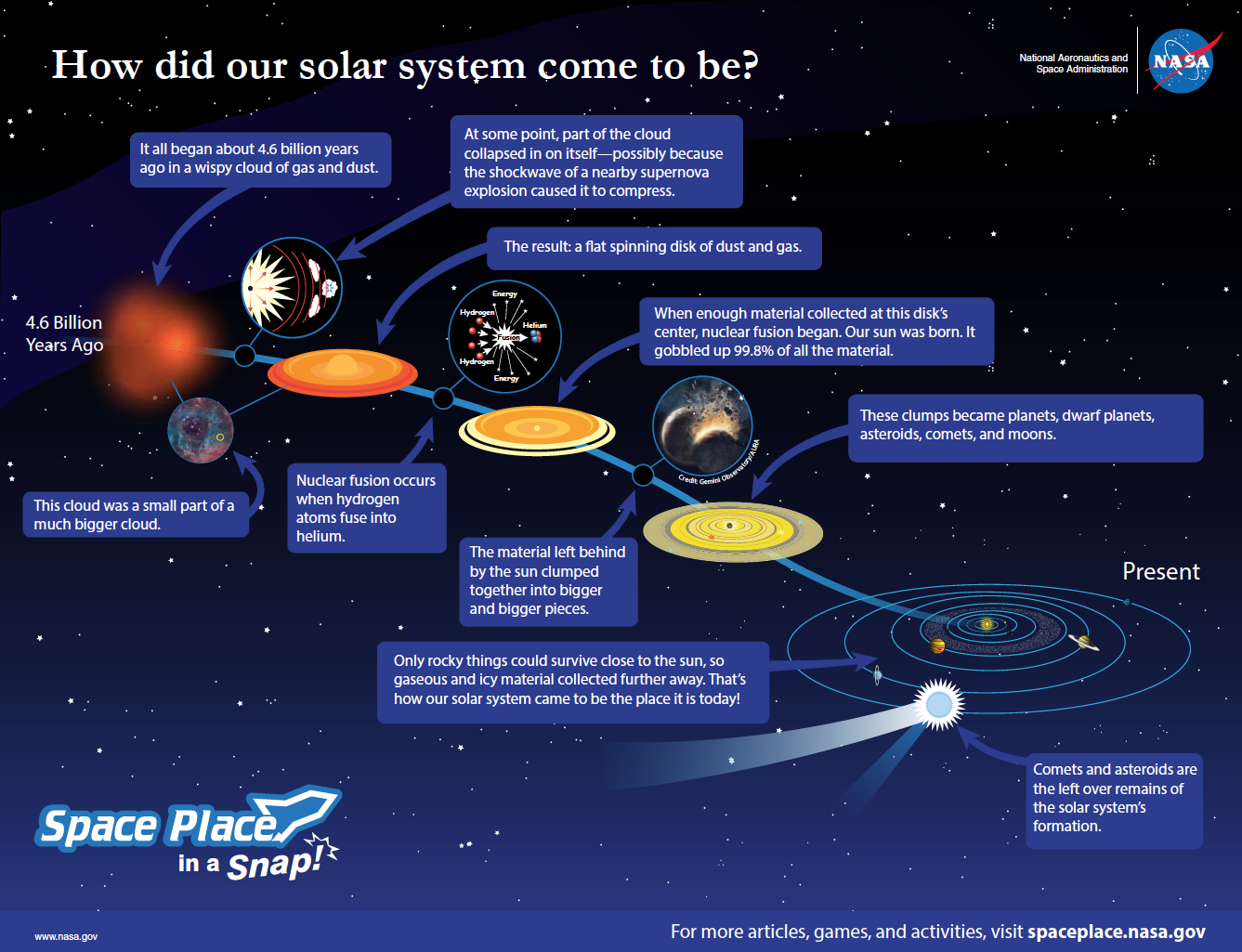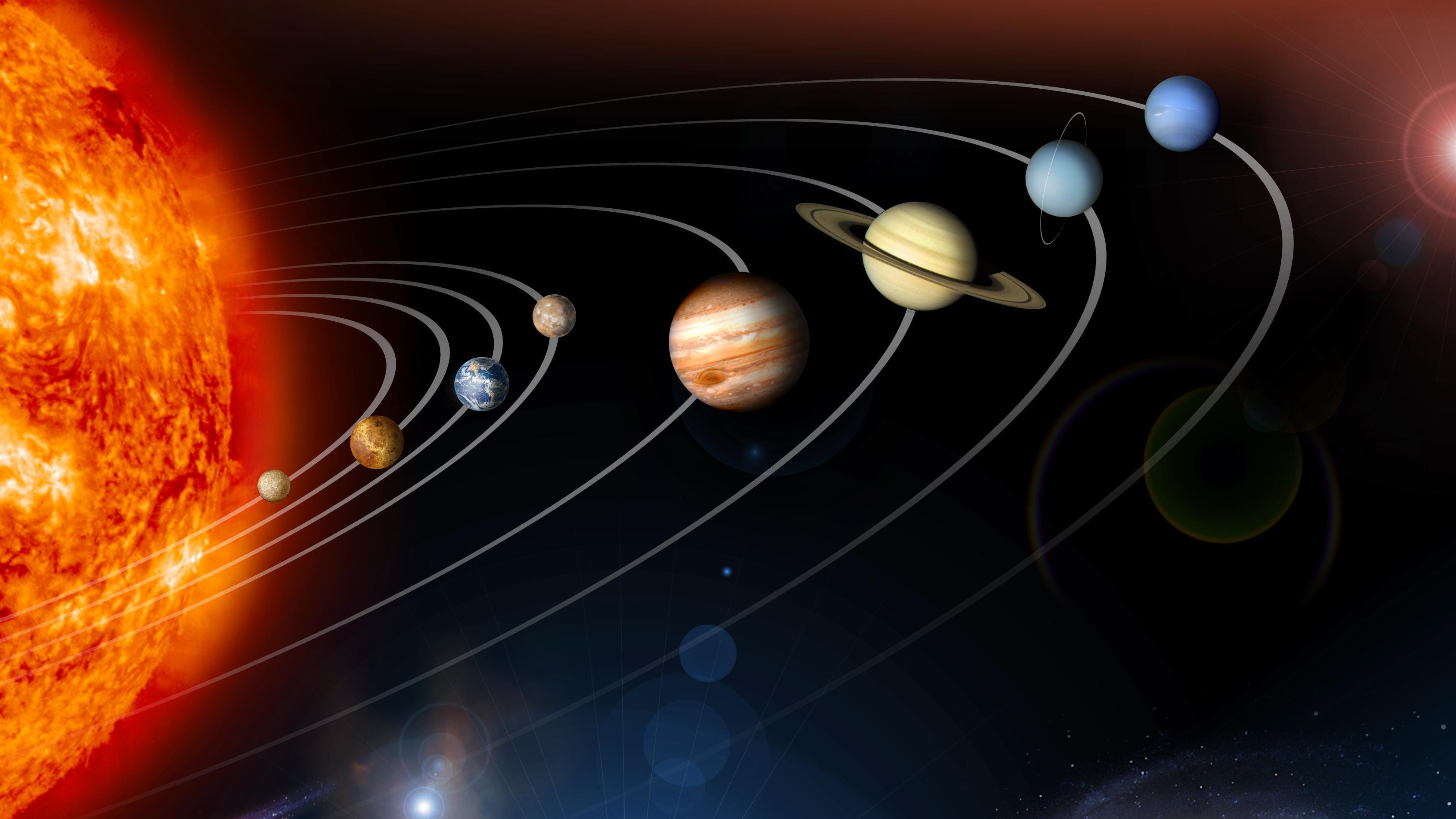Describe How Our Solar System Developed
The Sun formed in the center and the planets formed in a thin disk orbiting around it. Gas and icy stuff collected further away creating the gas and ice giants.

How Did The Solar System Form Nasa Space Place Nasa Science For Kids
Our Solar System and all other star systems form from a collapsing nebula.

. Decades of observation and spacecraft exploration have revealed that most of these objects formed together with the Sun about 45 billion years ago. In Ptolemys model the Earth was at the centre of the Universe with the Sun and planets revolving in a series of circular orbits moving out from the Earth. The solar system 1 consists of the Sun and many smaller objects.
Many places in the solar system provide these at least for a time. Over time these clumps can. We currently think that our solar system formed from a large nebula perhaps after the explosion of a nearby star.
This event led to the sun emerging from the cloud enveloped in gas and dust. In the ancient world theories of the origin of Earth and the objects seen in the sky were certainly much less constrained by fact. How did the solar system evolve to its current diverse state.
This model became known as the geocentric model. In the second century CE Ptolemy who lived in the Egyptian town of Alexandria produced a mathematical representation based on observation of the known Solar System. The Sun and the planets formed together 46 billion years ago from a cloud of gas and dust called the solar nebula.
All the foregoing constraints are consistent with the general idea introduced in Other Worlds. Over time he said gravity collected this material together to form orbiting worlds. The important event in the formation of solar system was the passing of sun through an interstellar cloud.
The Solar System is the gravitationally bound system of the Sun and the objects that orbit it. Not only planets but also some moons and even certain comets. Many of the other solar systems have massive Jupiter like planets close to their sun closer even than Mercury.
The processes that followed gave rise to the solar system complete with eight planets 181 moons and countless asteroids. The Sun sent out energy and particles in. Our solar system began forming about 46 billion years ago within a concentration of interstellar dust and hydrogen gas called a molecular cloud.
Rather they must have began out where our Jupiter is and moved inwards scattering the smaller planets with their powerful. It is generally accepted that like other planetary systems our solar system formed from an original molecular cloud protosolar cloud consisting mostly of hydrogen and helium with a rather small admixture of heavier elements. But for life to arise we presume that a hospitable environment must be more than just transient.
There are still leftover remains of the early days though. The formation of the Solar System began about 46 billion years ago with the gravitational collapse of a small part of a giant molecular cloud. An Introduction to the Solar System that the solar system formed 45 billion years ago out of a rotating cloud of vapor and dustwhich we call the solar nebulawith an initial composition similar to that of the Sun today.
Before the development of the telescope these ideas were based on. By the mid-1700s French mathematician Georges-Louis Leclerc was suggesting that the planets formed when a comet struck the Sun sending vast amounts of material surging outwards. A shock wave from a nearby supernova explosion probably initiated the collapse of the solar nebula.
As the amount of data on the planets moons comets and asteroids has grown so too have the problems faced by astronomers in forming theories of the origin of the solar system. Planets of the solar system gradually emerged from this envelope of gas and dust. The process started with the collapse of some fragment of a huge molecular cloud.
The planets their moons and rings and such debris as asteroids comets and dust. Most of the collapsing mass collected in the center forming the Sun while the rest flattened into a protoplanetary disk out of which the planets moons asteroids and other small Solar System bodies. Origin of the solar system.
They represent clumps of material that. According to a newer theory disk instability clumps of dust and gas bind together early in the solar systems existence. They are made up of mostly hydrogen but also contain other matter like gases dust ice and rock.
The way people think of the Solar System has changed many times throughout history. The solar system as we know it began life as a vast swirling cloud of gas and dust twisting through the universe without direction or form. The process of impacts and collisions in the early solar system was complex and apparently often random.
The cloud contracted under its own gravity and our proto-Sun formed in the hot dense center. The gravity of the nebula pulls this matter into the centre and the nebula experiences a gravitational collapse. As the solar nebula collapsed under its own gravity material.
The remainder of the cloud formed a swirling disk called the solar nebula. The Solar System formed 46 billion years ago from the gravitational collapse of a giant interstellar molecular cloud. Often called stellar nurseries nebulae are the birthplace of stars.
Solar system formation began approximately 45 billion years ago when gravity pulled a cloud of dust and gas together to form our solar system. When it comes to the formation of our Solar System the most widely accepted view is known as the Nebular Hypothesis. About 46 billion years ago this gigantic cloud was transformed into our Sun.
And like that the solar system as we know it today was formed. In 2007 researchers at the University of CaliforniaDavis determined that our Solar System was fully formed at 4568 billion years ago. As per the interstellar theory our solar system was formed from an interstellar cloud.
They did this by determining the age of stony materials from the asteroid belt. Many scientists now believe that these gas giants could not have formed there. The vast majority of the systems mass is in the Sun with most of the remaining mass contained in the planet Jupiter.
The solar nebula model can explain many of the regularities we find in the solar system but the random collisions of massive collections of planetesimals could be the reason for some exceptions to the rules of solar system behavior. Rocky planets like Earth formed near the Sun because icy and gaseous material couldnt survive close to all that heat. We believe that liquid water and carbon are required for life to arise and thrive as well as a source of energy.
In essence this theory states that the. Some big stars can explode something called a supernova and that explosion has enough energy to make the gas and dust in. Indeed a scientific approach to the origin of the.

Diagram Of The Solar System Universe Today

How Our Solar System Formed Article Khan Academy

No comments for "Describe How Our Solar System Developed"
Post a Comment